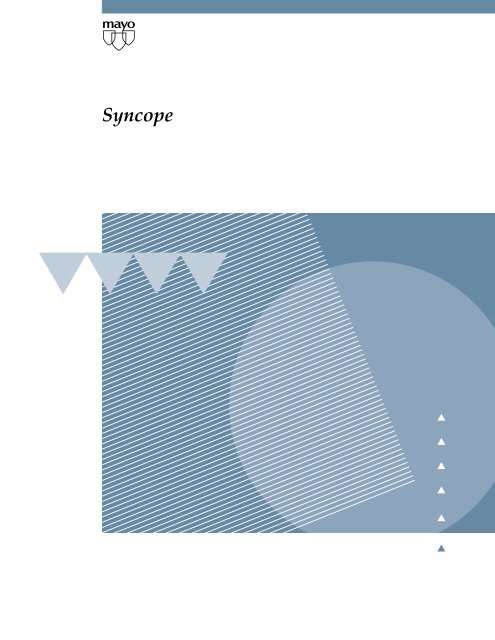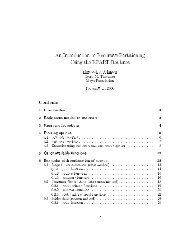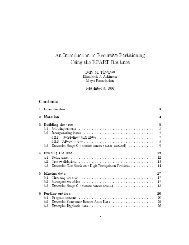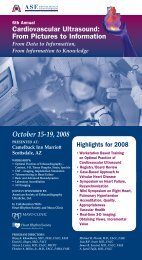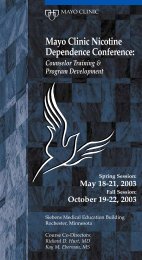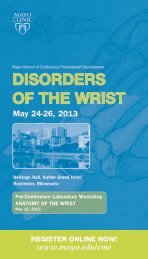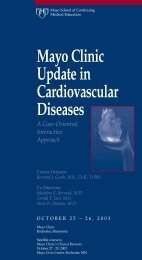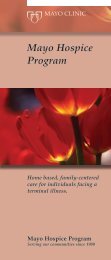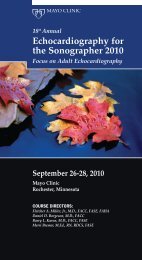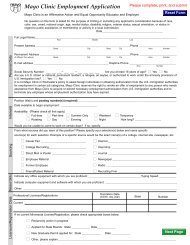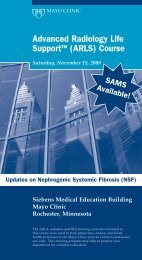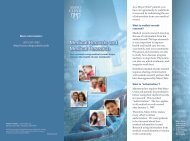Syncope - MC2945 - Mayo Clinic
Syncope - MC2945 - Mayo Clinic
Syncope - MC2945 - Mayo Clinic
Create successful ePaper yourself
Turn your PDF publications into a flip-book with our unique Google optimized e-Paper software.
<strong>Syncope</strong>
Introduction<br />
What is syncope?<br />
<strong>Syncope</strong> (SING-kuh-pee) is a medical term for fainting. When you faint,<br />
your brain is not receiving enough blood and oxygen, so you lose<br />
consciousness temporarily.<br />
How common is<br />
syncope?<br />
<strong>Syncope</strong> is a common problem. Approximately one million people are<br />
evaluated and treated for syncope in the United States each year. Since<br />
syncope can occur without warning, up to a third of the people who have<br />
syncope also have injuries related to falling or other accidents.<br />
How does<br />
syncope affect<br />
people?<br />
Some people have infrequent episodes of syncope that do not interfere<br />
with their lives. Others have repeated episodes, and for nearly a third of<br />
these people, the cause remains undetermined and untreated. They may<br />
have difficulty performing everyday activities such as working or driving<br />
a car. These changes to their lifestyles may then lead to other problems<br />
such as anxiety or depression. Untreated syncope especially affects older<br />
people because they frequently have injuries during episodes. However,<br />
most causes of syncope can be identified and treated.<br />
Heart specialists<br />
and syncope<br />
<strong>Syncope</strong> is often related to heart disease, so it is common for people with<br />
syncope to receive medical care from heart specialists. Cardiologists are<br />
physicians who specialize in the diagnosis and treatment of heart disease.<br />
Electrophysiologists are cardiologists who specialize in the diagnosis and<br />
treatment of syncope and problems related to heart rhythms.<br />
The rhythm of your heartbeats is important. To pump blood efficiently,<br />
your heart muscles must contract and relax in a coordinated manner at a<br />
proper rate. Contraction and relaxation are controlled by electrical<br />
messages that travel through heart muscle like electricity through wires.<br />
If the electrical current does not spread through the heart muscle properly,<br />
abnormal heart rhythms develop. These rhythms, called arrhythmias,<br />
reduce the performance of the heart. Sometimes arrhythmias cause<br />
syncope.<br />
1
Causes of <strong>Syncope</strong><br />
Types of syncope, named according to the cause, include the following:<br />
1. Cardiogenic syncope is usually related to abnormal heart rhythms.<br />
Probably one-fourth of all episodes of syncope are cardiogenic. Fainting<br />
that is triggered by underlying heart problems is usually more serious<br />
than fainting triggered by other causes.<br />
2. Neurocardiogenic syncope, also called the common faint or vasovagal<br />
syncope, occurs in 25 to 40 percent of the people who have syncope.<br />
These episodes are related to problems with both the heart and the<br />
nervous system.<br />
3. Neurologic syncope is related to problems with the nervous system,<br />
such as seizures.<br />
4. Metabolic syncope is caused by disturbances of the chemical functions<br />
within the body, such as low blood sugar (hypoglycemia) or<br />
hyperventilation with or without perceived anxiety (which causes an<br />
imbalance of gases in your bloodstream).<br />
5. Psychogenic syncope can be triggered by states of mind, such as<br />
anxiety, hysteria, panic or major depression.<br />
6. Orthostatic hypotension is characterized by your blood pressure<br />
dropping when you stand.<br />
7. <strong>Syncope</strong> of undetermined etiology is a category for syncope of<br />
unknown causes.<br />
2
Diagnosis of <strong>Syncope</strong><br />
History and<br />
physical<br />
examination<br />
The most important steps in determining the cause of syncope are when<br />
you and your physician talk about your health and your syncope (called a<br />
clinical history) and when your physician performs a physical<br />
examination. During physical examinations, physicians look, listen and<br />
feel for signs of abnormalities in your body that may cause syncope. For<br />
example, listening to your heart with a stethoscope gives your physician<br />
basic information about the rate and rhythm of your heartbeat. The<br />
clinical history provides clues to the cause of syncope such as the<br />
following examples.<br />
Cardiogenic syncope<br />
• Episodes of cardiogenic syncope tend to occur quickly, sometimes<br />
preceded by other symptoms that suggest heart problems such as chest<br />
tightness, shortness of breath, sweating, apprehension or palpitations<br />
(the sensation of your heart pounding or beating rapidly). Sometimes<br />
syncope occurs when palpitations suddenly stop.<br />
• <strong>Syncope</strong> occurring during exercise may indicate a cause related to the<br />
heart.<br />
• Telling your physician about all of your medications is important<br />
because some may lower your blood pressure or slow your heart rate<br />
enough to cause syncope.<br />
• Older people with heart disease are more likely to have cardiogenic<br />
syncope than are younger people without heart disease.<br />
Neurocardiogenic syncope<br />
• The common faint often occurs as a response to an emotionally<br />
disturbing event, but it may also occur without warning. Describing<br />
information about the environments or other circumstances when you<br />
have fainted helps your physician understand your syncope.<br />
Neurocardiogenic syncope can be triggered by the sight of blood, by<br />
loss of blood or by suddenly stressful or painful experiences. Some<br />
adults fainted as children.<br />
• Before they faint, some people experience warning signs such as<br />
paleness, weakness, light-headedness, yawning, nausea, sweating,<br />
hyperventilation, blurred vision and difficulty hearing. If they<br />
recognize these signs, they may be able to avoid fainting by sitting or<br />
lying down promptly.<br />
• After a common faint, people may feel weak, but usually they are not<br />
confused.<br />
3
Neurologic syncope<br />
• Often before a seizure, people have an aura (the sensation of unusual<br />
sights or smells).<br />
• During a seizure, people lose consciousness suddenly. They may be<br />
sitting, standing or lying down when it occurs. They may lose urinary<br />
or bowel control and bite their tongues.<br />
• After a seizure, people may be confused and drowsy.<br />
• Unlike seizures, strokes usually cause symptoms such as muscle<br />
weakness (including paralysis, or being unable to move a part of the<br />
body), slurred speech, altered consciousness, or vision or other sensory<br />
disturbances.<br />
Orthostatic hypotension<br />
• If you faint when you stand after you have been sitting or lying down,<br />
your syncope may be caused by orthostatic hypotension.<br />
• To learn why your blood pressure drops, your physician needs to know<br />
if you are taking any medications that could lower your blood pressure.<br />
Blood pressure may also drop after eating, and during coughing,<br />
swallowing, urinating or having a bowel movement.<br />
Diagnostic<br />
testing<br />
Besides the clinical history and physical examination, additional cardiac,<br />
neurologic, metabolic or psychiatric evaluations may be necessary to<br />
evaluate syncope. Examples of specific procedures that may be performed<br />
are electrocardiography and 24-hour Holter monitoring, event recording,<br />
electrophysiology testing and tilt-table testing.<br />
Electrocardiography and Holter monitoring<br />
An electrocardiogram (ECG or EKG) is a recording of the electrical activity<br />
of your heart that is usually made during a short period of several beats<br />
(figure 1). A Holter monitor is a device you wear that produces a<br />
continuous, 24-hour recording of your heart rhythm (figure 2). However,<br />
the chance that you would faint during one of these brief measurement<br />
periods may be small.<br />
4
Figure 1. During electrocardiography, adhesive skin electrodes are attached to your chest<br />
and limbs to record the electrical activity of your heart while you rest. Usually the<br />
recording takes no more than a minute.<br />
Figure 2. A Holter monitor records<br />
each of your heartbeats as you<br />
perform your everyday activities.<br />
Small electrodes stick to your skin<br />
and connect to a portable recording<br />
device that you wear (in this<br />
drawing the recorder is hanging by<br />
a strap at the man’s left side).<br />
5
Event recorders<br />
Event recorders are used to help diagnose heart abnormalities that occur<br />
infrequently (figure 3). An event recorder is worn like a Holter monitor,<br />
but it is worn for a longer time, such as a month. When you feel a<br />
symptom occurring, you press a button on the device, and then the device<br />
records your heart’s electrical activity for several minutes. In this way<br />
your physician may study your heart’s electrical activity during an<br />
episode of syncope. Event recorders may be worn outside your body or<br />
inserted under the skin by a minor surgical procedure.<br />
Figure 3. This drawing shows a man learning how to use an event recorder he will wear<br />
for the next month. During that time, he will push a button when he feels a symptom<br />
occurring. The event recorder will then save a record of his heart’s electrical activity for<br />
several minutes before and after the button was pushed. His physician will analyze the<br />
information later. (The dashed lines represent wires and adhesive electrodes on the<br />
man’s skin, under his shirt.)<br />
6
Electrophysiology testing<br />
Some people faint because they have life-threatening heart rhythms that<br />
are too slow (bradyarrhythmias) or too fast (tachyarrhythmias). For these<br />
people, electrophysiology testing may be the most useful diagnostic test<br />
(figure 4). It is a way of determining whether electrical impulses are<br />
traveling through the heart muscle normally or abnormally. During<br />
electrophysiology testing, electrode wires are inserted through blood<br />
vessels into the chambers of the heart. The wires can be used to record<br />
electrical activity or to stimulate the heart into abnormal rhythms so it can<br />
be examined under different conditions. The three usual reasons to<br />
perform electrophysiology testing are the following:<br />
1. To establish the diagnosis<br />
2. To evaluate relationships among symptoms, abnormal rhythms and<br />
blood pressure changes<br />
3. To assess responses to treatment<br />
Figure 4. During electrophysiology testing, you lie on an X-ray table. A large camera<br />
sends images of your heart to nearby video screens. The room has special equipment,<br />
including heart monitors.<br />
7
Tilt-table testing<br />
Tilt-table testing, where you lie on an examination table that is tilted into<br />
different positions, is a useful test for people with unexplained syncope<br />
(figure 5). However, the results need to be interpreted with caution since<br />
the conditions during the test are not the same as during a usual episode<br />
of fainting.<br />
Figure 5. The woman in this drawing has been tilted into a vertical position during tilttable<br />
testing. The table’s straps and supports hold her securely as the table tilts.<br />
8
Treatment of <strong>Syncope</strong><br />
When the exact cause of syncope is determined, the most appropriate<br />
treatment is usually obvious. However, when the cause is not completely<br />
known, decisions about treatment can be difficult. The following are<br />
examples of treatment for specific causes of syncope.<br />
Treatment for<br />
bradycardia<br />
The preferred treatment for bradycardia (slow heart rhythm) is to implant<br />
a pacemaker. A pacemaker is an electrical device that causes the heart to<br />
beat by releasing a series of electrical impulses.<br />
Treatment for<br />
tachycardia<br />
Treatment for tachycardia (rapid heart rhythm) depends on the nature of<br />
the tachycardia. Usually this information is obtained through<br />
electrophysiology testing. Treatment may include the following:<br />
• Medications<br />
• Ablation — A procedure that destroys abnormal electrical pathways in<br />
the heart<br />
• Defibrillator — A device resembling a pacemaker that treats lifethreatening<br />
tachycardias<br />
Treatment for<br />
neurocardiogenic<br />
syncope<br />
When people have infrequent episodes of common faint preceded by<br />
warning symptoms, treatment may not be required. Often if a person is<br />
aware of the warning symptoms, loss of consciousness can be prevented<br />
by sitting or lying down, or lowering the head while sitting. Drinking<br />
extra water in hot weather is another simple step that decreases the<br />
chances of fainting.<br />
If people have frequent episodes of neurocardiogenic syncope, they may<br />
need treatment with medications or, rarely, with a pacemaker. Several<br />
medications are available, but the dosages need to be adjusted carefully<br />
under the supervision of a physician. Side effects of many of the<br />
medications may prevent their long-term use.<br />
9
Conclusion<br />
<strong>Syncope</strong> can be challenging to diagnose and treat. Successful treatment<br />
requires accurate diagnosis, so all fainting should be evaluated carefully to<br />
determine a diagnosis, appropriate treatment and follow-up care.<br />
Additional information about syncope and heart arrhythmias can be<br />
found on the World Wide Web at http://www.mayo.edu/heartbeat.<br />
10
Notes<br />
11
Notes<br />
12
<strong>Mayo</strong> Press<br />
200 First Street SW<br />
Rochester, Minnesota 55905<br />
http://www.mayo.edu<br />
© 1999, <strong>Mayo</strong> Press<br />
MAYO, MAYO CLINIC<br />
and the <strong>Mayo</strong> triple-shield<br />
logo are registered marks of<br />
<strong>Mayo</strong> Foundation for Medical<br />
Education and Research.<br />
<strong>MC2945</strong>


